Here’s How the NFL Can Evolve Into a Content Platform
The NFL has an unprecedented opportunity to build itself out as a true platform.
After the Rio Olympics, Stratechery’s Ben Thompson wrote an article questioning the fate of live sports. With streaming viewership up, Nielsen ratings down, and 50 million people just watching highlights on Snapchat, he urged media executives to consider whether sports in general was “must-see TV today, just another stream on Snapchat tomorrow.” But Thompson’s nuclear scenario—advertisers fleeing the networks, the networks collapsing, and Snapchat or another platform taking over—assumes that the NFL and other sports leagues aren’t going to fight back.
The mobile NFL
If you look at how advertisers are spending their money, there’s good reason to bet on viewers continuing to migrate from the cable box to the mobile device:
(Source)
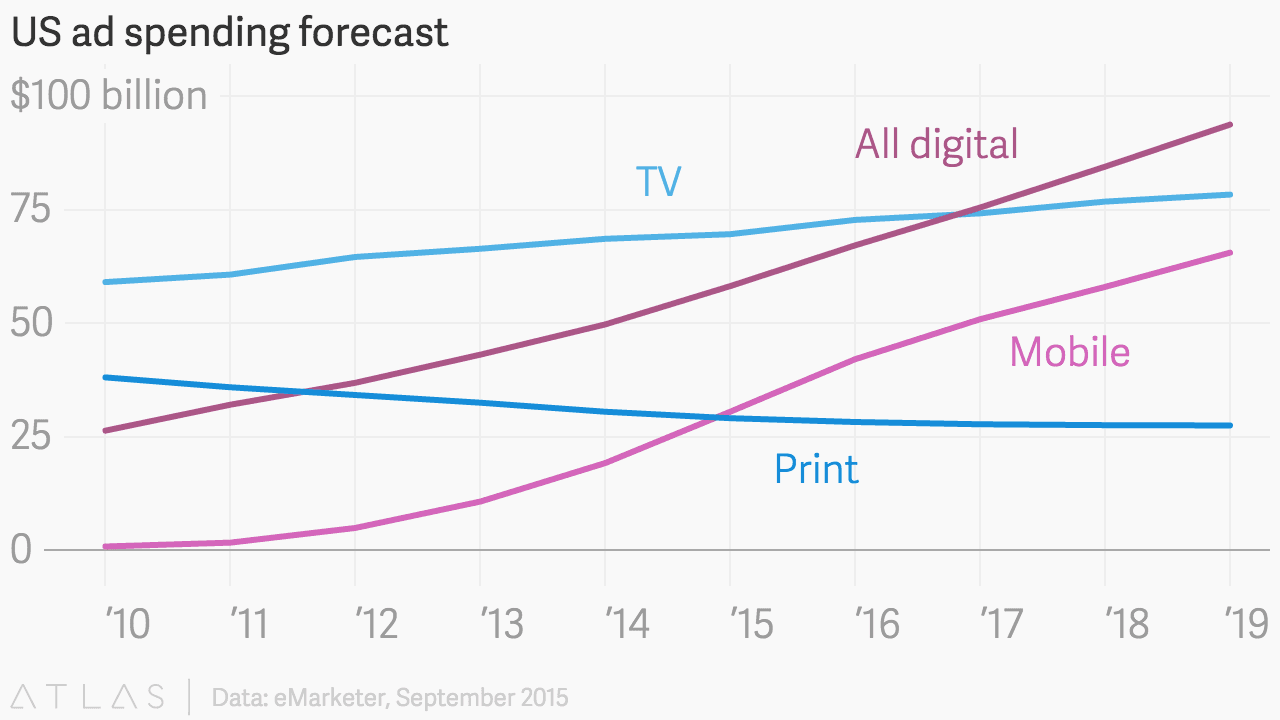
While TV ad spend levels off, mobile ad spend continues to increase year over year. Ad money simply goes where the eyeballs are, which—especially with millennials—means it’s going to mobile apps like Snapchat. Content aggregation has slowly eroded traditional publishers, and Thompson warns that live sports could meet the same fate.
But the NFL is not in the same position as traditional publishers. Local newspapers and undifferentiated media outlets suffered from the rise of aggregators because their only real advantage—control over the distribution channel—was upended. The NFL doesn’t have this problem because they own one of, if not the most valuable content property in the world. Football.
Super Bowl 50 broke streaming records with nearly 4 million online watchers. That paved the way for 2016, the first year of every game being streamed online. Those focused solely on Nielsen ratings are missing a much larger trend, one that is only growing in importance and that is centered largely on the mobile device.
The NFL as a platform
The law of the internet, as Twitter’s Ev Williams has said, is that all successful companies are essentially the same. They don’t win because they come up with some novel idea. They win because they fulfill people’s human desires in a more efficient or better way than whatever came before.
Google got you information faster. Amazon got you stuff faster. The iPhone came out, allowing you to walk around with a computer in your pocket and communicate faster. Uber got you from point A to point B faster.
And so on.
The shift to mobile as a full platform is still in motion, but you can already see how it’s changed viewing habits. Second-screen viewing is a well-known phenomenon. 87% of TV viewers are looking at a phone while they watch TV. Millions more are watching football just on their phones and tablets.
But it’s not just about watching football. A whole generation is growing up with no concept of mobile devices as secondary to home PCs—for them, they’re essentially computers. By engaging this audience and experimenting with new ways of delivering content over mobile, the NFL has an opportunity to kick-start and guide the next great transition in how fans interact with football. But to become a platform, they need to start thinking like one.
They need to find Aha! moments
All successful mobile platforms—Instagram, Snapchat, Facebook—are like nightclubs. They’re only fun as long as your friends are there. Or, more accurately, they’re only fun as long as there’s content. To start getting that content, all of them at one point had to acquire users and convince them of the value of the product they were offering. They had to show people they were worth their attention. We call the individual tipping points where users become convinced “Aha! moments.”
Aha! moments take place when users take an action or reach a threshold that shows them the true value of a product. It takes a lot of intuition, a lot of experimentation, and a lot of trial-and-error to discover truly powerful Aha! moments. Three common types of Aha! moment are:
- Social: Occurs after users make a certain number of connections in
xdays - Content: Occurs after users contribute
xamount of content - Return: Occurs after users return to the app
xtimes afterxdays
At Facebook, under the guidance of Growth team lead Chamath Palihapitiya, the Aha! moment that got them on the path to a billion users was social. After users added a total of 7 friends in 10 days, the team found, those users were far more likely to stick around than your average new user—like hitting that threshold flipped a switch in their brains.
Every big success story in consumer tech has run into the same pattern. Growth is slow, comparatively. The team works to figure out what gets people engaged. And then suddenly, like a flash of lightning, there’s a realization—_this_is what people need to do to get really hooked.
For the love of the game
Everyone who loves football has their own version of the Aha! moment, that point where they see and feel why this sport is so important. High school defensive back Ethan Negron describes the moment he realized he wanted to play football full-time as an Aha! moment. Having quit his school team once before, he attends a USA Football Regional Development camp where he runs through some solo practice reps. Then team practice starts:
We got to 7on7s, that’s what flipped the switch… It’s much more of a team concept, and when I was out there with everyone I thought, “Yeah, I’m playing high school football. This is what I want to do.”
Even those of us who just watch football have stories about how we first fell in love with the game. Watching our local team play under the lights on a Friday night. Seeing our team go all the way to the Superbowl. Witnessing a transcendent moment like The Catch, The Drive, or one of Terrell Owens’ touchdown celebrations.
To become a platform, the NFL is going to have to figure out how to deliver those kinds of Aha! moments on the mobile scale and give its app’s users something that will make them want to come back time and time again.
Form a hypothesis and investigate it
To begin looking for Aha! moments, let’s start with a hypothesis about how the NFL’s mobile app is delivering value to its users and how it could deliver more. There are many places we could start, but one of the most powerful trends on mobile is personalization. That dovetails with the way people interact with football. Most primarily care about their team.
(Note: The following data are completely hypothetical.)
Let’s start with a basic content-based thesis: that users who put in the effort to personalize their experience in the NFL app have a better experience and are more likely to return because they get more value. They’re opening the NFL app day after day to engage with their team, to watch videos and review highlights from last week’s game, get stat breakdowns, and look at upcoming matchups.
If it turns out that users do like personalization, then the sky is the limit. Think of the effect that SportsCenter had on TV and how we interact with sports—now imagine an app that gives you a SportsCenter-like digest of information tailored completely to your interests and desires. Highlights, historical stats, news, recaps, interactive tools, data-driven insights and more. Sounds good, but first we should assess whether the NFL’s in-app personalization as it exists now is working.
Making observations
If we can show that users who personalize their experience tend to come back more often than other users, than we have grounds on which to proceed with an experiment to make that personalization mechanism even more powerful and engaging. To begin investigating this thesis, we’ll use start by first assessing the lay of the land by using Amplitude Compass.
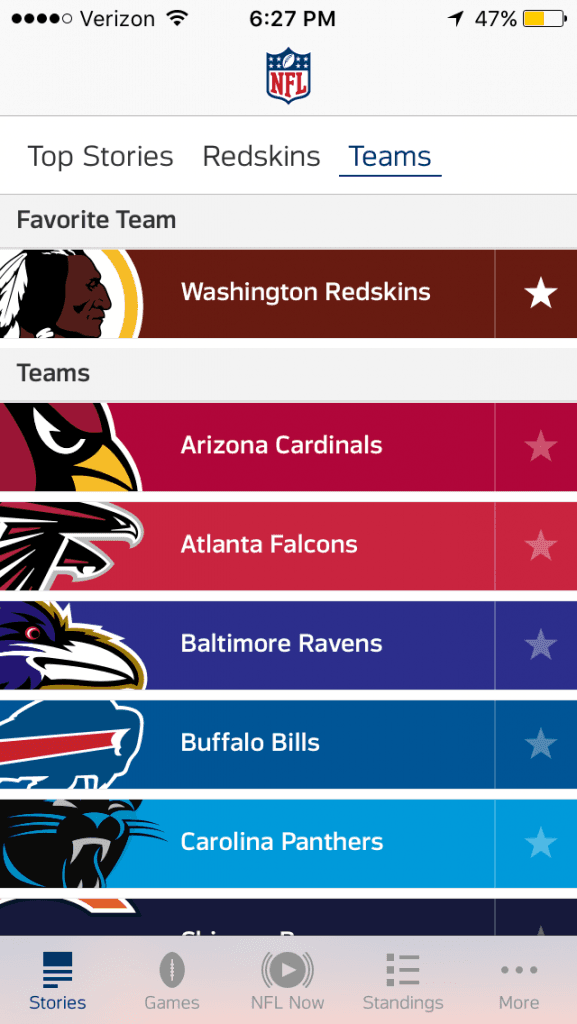
This tool is designed to help mobile developers seek out Aha! moments in their apps. It works by first tagging each “event” in an app—everything from signing in to watching a video—and then tying those events to the unique IDs of the users that take them. Following users through their lifecycles, Amplitude can then figure out which kinds of actions users take on their way to Aha! moments—in other words, what gets users hooked.
The chart below shows a hypothetical distribution of events in the official NFL app. For each event on the left, you can see how well performing that action within x days of signing up correlates with 2nd-week retention, or the likelihood of a user returning to the app two weeks later. “PickFavoriteTeam” has a correlation score of 0.58 when users perform it within the first seven days, which means it has a high correlation with two-week retention.
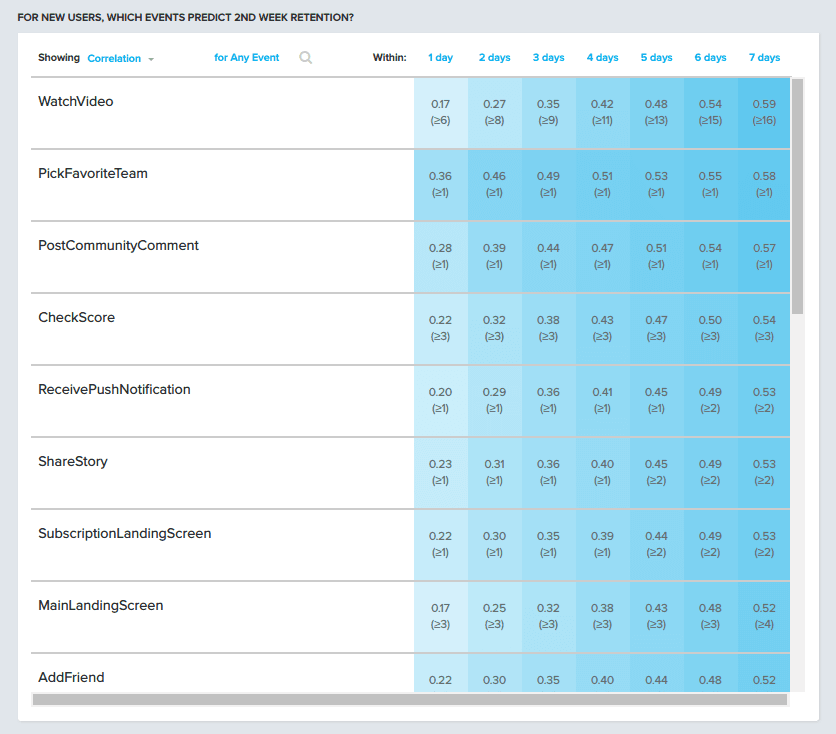
In other words, if a user picks a team they want to follow within their first week of using the app, they’re more likely to be coming back two weeks from now. Clicking on a correlation score brings up a menu with more information about that particular combination of event and frequency:

This view gives you information about how many overall users performed that particular activity, how Amplitude ranks the correlation score (“Highly Predictive,” in this case) and more. Here we see that while “PickFavoriteTeam” is a highly predictive indicator of 2-week retention, only 17.3% of all users ever do it. That tells us that a majority of the app’s users aren’t taking advantage of the option to personalize their experience:
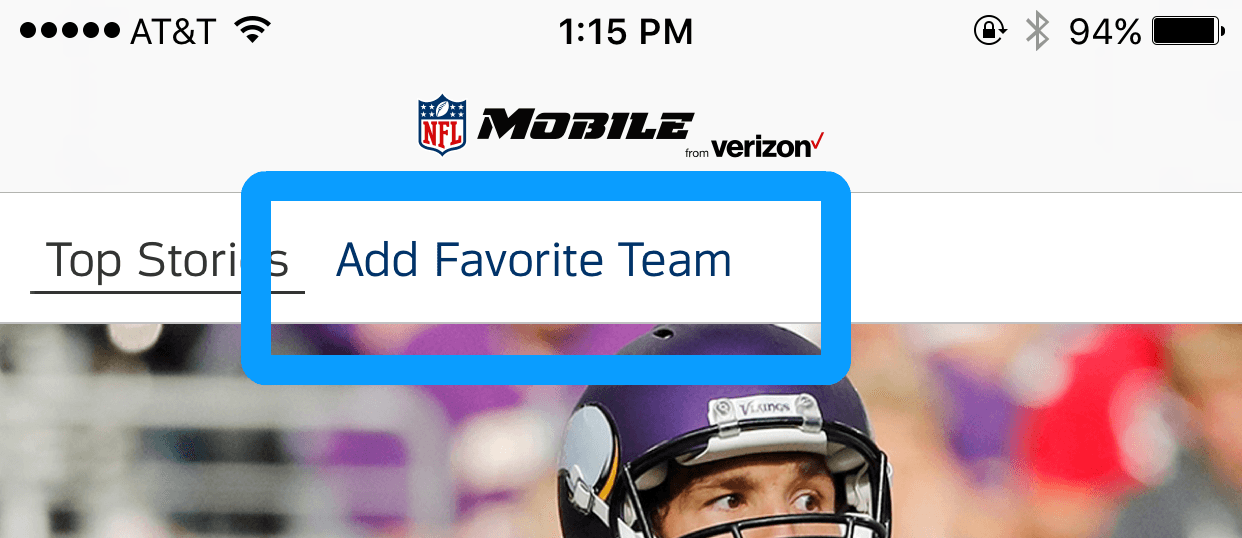
We have good reason to think that personalization is being under-utilized, but first let’s get granular and provide more support for the existence of this trend by looking at personalization behavior using cohorts.
Examining behavior with cohorts
Like in statistics and medicine, a cohort is a group of people with some shared set of characteristics set apart for study. But behavioral cohorts aren’t concerned first and foremost with who someone is—they’re concerned with what they do. So app developers use behavioral cohorts to set apart groups of users they want to understand in more detail by the actions they take in-app. In this case, we want to understand more about those users who personalized their feeds.
First, we’ll examine the cohort of users that picked a favorite team inside their first week alongside a generic cohort made up of “all users.” For this study, we’ll also look at those users who did not pick a favorite team inside their first week and compare all three when it comes to in-app retention. As you can see from this (hypothetical) data, those users who picked a favorite team are significantly more likely to return every day within their first 30 days after signing up:

The left vertical axis corresponds to the percentage of users in that cohort who returned—so on Day 1, the first day after signing up, we can see that about 75% of users who picked a favorite team returned. Only about 39% and 30% of users returned from the “All users” cohort and the cohort for users that didn’t pick a favorite team, respectively. We now have even more data to back up our hypothesis that feed personalization has a positive effect on user retention. But it’s important to remember that correlation doesn’t equal causation.
The simple fact that users who pick their favorite teams seem to stick around longer does not mean it would be right to start bombarding users with push notifications prompting them to pick their favorite team. It’s not necessarily the case that picking a favorite team causes engagement—it could merely be that already-engaged users are more likely to personalize their feed. To find out if it’s correlation or causation, you need to experiment.
How a new onboarding flow might work
Let’s experiment with this idea that people who pick a favorite team tend to stick around longer. We’re going to model how a new onboarding flow for the NFL app might help bring more users to a personalized feed faster, thus giving them more value and encouraging them to return more often.
The official NFL app currently only has one step to the onboarding process—choosing “OK” or “Cancel” in response to a request to send push notifications. To get from there to a personalized feed, there are two more steps:

There’s no guidance to the user here. New users don’t know that picking their favorite team will personalize their main feed, and they don’t know that doing so will mean seeing content they’re more interested in. Here’s how it could work instead. The very first screen prompts you to pick a favorite team rather than showing you a default page. The second screen then presents you with your personalized feed:
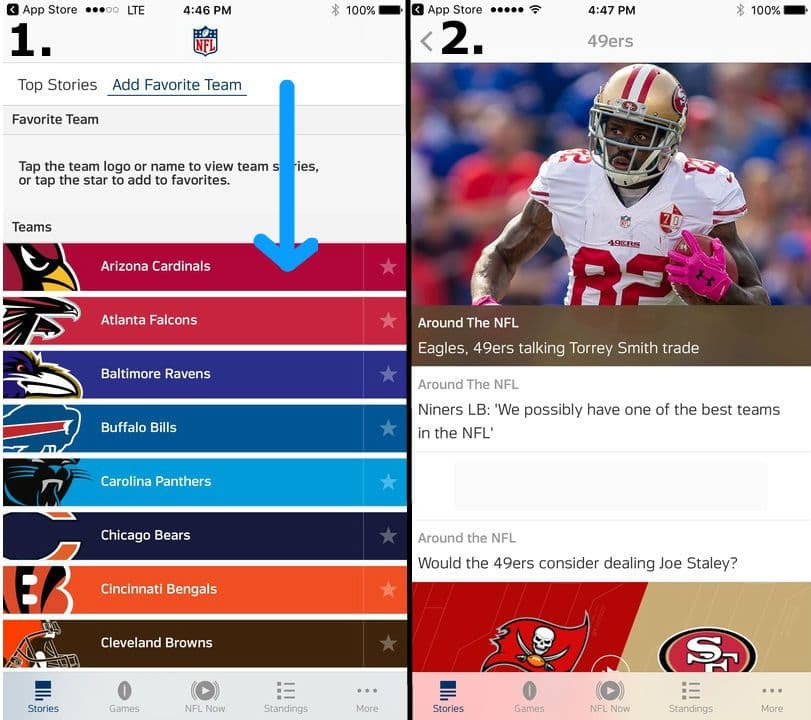
Rather than hope that users will personalize their experience and offer up a generic experience by default, this flow forces users to pick their favorite team from the very start. It makes personalization into a core aspect of the app, and if our hypothesis is accurate, will drive a lift in user activity and retention.
Evaluating the results
A new onboarding flow is just one way to test a hypothesis about retention. You could try to guide users to an “Add Favorite Team” option with a tooltip, or encourage them to interact with it using a modal window. The most important aspect of experimenting with your app’s design and user experience is having one metric by which you can gauge success.
For content-based businesses, this will usually be some kind of return metric—are people coming back to the app every day? Every week? It may also have an activity tied to it: are they watching videos and reading articles? Some experiments will be binary—a new onboarding flow either improves retention or it doesn’t. Others will be more minute, more gradual, more iterative. Building a data-driven framework for growth means allowing for the existence of both and pursuing whatever will help you bring more value to your users faster.
The NFL has good problems
Whatever problems the NFL is having, our position is that they are good problems. We have never had as many options for how and where to watch football as we do now. That means it’s harder to get an accurate measure of viewership, and more likely for the actual numbers to go under-reported. It means that to stay relevant the NFL has to update how it interacts with fans, just like they did when cable TV took over and again when the subscription TV model took over. It also means that today, the NFL has an unprecedented opportunity to build itself out as a true platform. And as the world, and all the content in it shifts to mobile, we believe that this is all but inevitable.

Archana Madhavan
Senior Learning Experience Designer, Amplitude
Archana is a Senior Learning Experience Designer on the Customer Education team at Amplitude. She develops educational content and courses to help Amplitude users better analyze their customer data to build better products.
More from Archana




